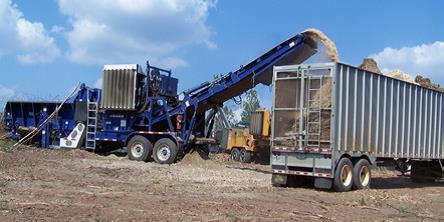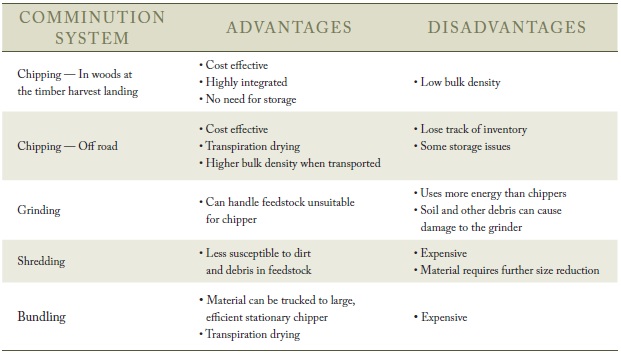Introduction
Pre-processing and drying woody biomass are important issues to address in every situation. They particularly affect transportation costs and combustion efficiency at the end-use location. Both should address four critical characteristics of biomass: particle size, moisture content, grit contamination, and wood quality. Woody biomass is typically pre-processed during or after a timber harvest operation and may be dried after a harvest but before transport to facilitate efficient transport, material handling, and utilization. While there are a number of woody biomass pre-processing and drying method options, optimum treatment of the biomass depends on the characteristics of the material, the end-use, and site management requirements. This fact sheet provides a brief description of the various pre-processing and drying technologies. It also discusses advantages and disadvantages of each technology.
Pre–processing
Comminution. The most common woody biomass pre-processing operation is comminution by chipper, grinder or shredder. The choice and location of a comminution device in the woody biomass fuel supply chain are among the most important components of a processing supply system for woody biomass (1). Factors affecting comminution choices include customer requirements for the raw material, total woody biomass volume, forest stand characteristics and nature of the road network, accessibility and equipment at the end-user reception facility, and feasibility of creating terminals for efficient handling and storage without incurring excessive additional haul distances.
The end user defines the desired particle size of woody biomass. A rule of thumb is that the size must be small enough to be conveyed without the material binding up or bridging. These problems occur when comminuted material, particularly wet or green material, mats together, making it hard for a chip van’s moving floors to work properly. Several biomass power plants in the U.S. have material specifications that provide for nominal, 3-inch material . Almost all of the material pieces are three inches or less in any dimension.
Chippers. Chippers cut woody material with a slicing action. They make up most of the woody biomass size-reduction equipment in use today and are characterized by high output, high-speed cutting knives. Most chippers have the capacity to blow chips into transport trailers for hauling (Image 1). They rely on sharp knives and, unfortunately, are susceptible to knife wear from high soil content, metal contamination, rocks, and stone. Chippers are well integrated into existing timber harvesting systems.

Image 1. In-woods Chipper source: Michael Westbrook, University of Georgia
Chippers are customarily placed either off-road, at the timber harvest landing, or on-site at the mill or plant. Chippers placed at the landing are often mounted on trucks. Loading custom chip vehicles at the landing is a highly sensitive and costly system because the material being shipped has a high moisture content. Chipping relies on the smooth functioning of all steps in the woody biomass supply chain. Downtime is costly when a delay occurs at the chipper, on the truck or at the facility. This problem is greatest when a container system or custom chip vehicle is used.
Off-road woody biomass chipping is an alternative method. Piles of logging residues left by the harvester or feller/buncher are chipped in late summer or early autumn at the logging site. This method is used to moderate the supply of wood chips during periods of low demand that often exist in the southern U.S. It produces high-quality biomass at a competitive cost because the biomass is allowed time to dry. Off-road woody biomass chipping is not practiced very much in the Southeast because it is a capital-intensive, two-pass system with high operational and transportation costs. However, it may provide a niche opportunity for independent contractors, separate from the conventional harvest, specializing in the recovery of woody biomass.
Use of a large mobile or stationary woody biomass chipper or crusher at the end use plant is another option. This method can save two-thirds of the cost associated with conventional off-road chipping at the logging site because of economies of scale, and powerful equipment can be used (2). Offsetting the advantages are increased noise levels at the plant, and the need for storage of uncomminuted woody biomass. (Image 2)

Image 2. Stationary Chipper source: Dale Greene, University of Georgia
Grinders. Grinders reduce woody biomass particles in size by repeatedly pounding them into smaller pieces through a combination of tensile, shear and compressive forces. Most are derivatives of hammer mills and include horizontal feed grinders (Image 3). Grinders accept a wider range of piece sizes. They will even accept short, non-oriented pieces including stumps, tops, brush, and large forked branches. Grinders rely on hitting a piece of wood often enough to finally break it into the desired size, usually with high speed rotating hammers. They require more energy than chippers per ton of output. Additionally, excessive soil contamination can increase internal wear.

Image 3. Horizontal Grinder source: Dale Greene, University of Georgia
Shredders. Shredders are slow-speed rip/ shear devices, used widely in comminuting trees removed at residential and commercial construction sites. Material is pinched between rotating devices and ripped apart or sheared (Image 4). Shredders are used where significant contamination is evident because the internal parts are slow moving. It avoids damage due to metal, rock, or concrete. They are not widely used in woody biomass operations because their capital cost is high and the particle size is larger and less uniform than a chipper can achieve. Material from shredders may require further size reduction if used as a biomass product.

Image 4. Shredder source: Ben Jackson, University of Georgia
Bundler and Composite Residue Log (CRL) Operations. Bundlers collect, compress, and bind forest residues into cylindrical bundles about 2 feet in diameter and 10 feet long (Image 5). This simplifies handling forest residues by compacting loose slash into a form that resembles a log. The bundling process enables forest residues to be shipped to conversion centers for more efficient size reduction. Woody residue material needs to be properly deposited on the ground to allow efficient bundling. While forest residue bundling is an attractive alternative, it is not currently cost effective. Please see “Forms of Biomass Feedstock for Bioenergy and Bio-based Products” for additional information about CRLs.

Image 5. John Deere 1490d Energy Wood Harvester source: Bob Rummer, USDAForest Service
Drying
After felling, the moisture content found in woody biomass depends largely on post-harvest handling and storage conditions. Moisture may be lost by transpiration drying, through foliage or open wood surfaces. The rate of woody biomass drying depends on many factors, including ambient temperature, relative humidity, wind speed, season, rainfall pattern, tree species, and tree size. In the South, the best season for drying is usually the summer.
Transpiration drying, also known as “leaf seasoning” and “biological drying,” occurs when felled trees are left for several weeks with the tops, branches, and leaves intact (3). The foliage continues to pull water out of the bole through transpiration until it dies and falls completely off the tree. Such drying can be successful with most tree species. Excessive precipitation or low temperatures may hinder the efficiency of transpiration drying, if on-site storage is extended to late fall or even until winter in temperate countries (4). Additionally, there are added costs in allowing woody biomass to dry before processing. Capital is tied up in the drying material. Moving equipment to the site is expensive to collect, pre-process, and transport the woody biomass.
An additional step to facilitate faster woody biomass drying is the use of a prototype roller crusher. The machine crushes smaller diameter stems and facilitates drying by opening the biomass to the transpiration drying effect. This step is costly financially. Additionally, crushing introduces a significant amount of dirt into woody biomass, which can affect pre-processing and conversion.
Summary and Conclusions
A variety of possibilities exist for pre-processing and drying. Table 1 summarizes some of the advantages and disadvantages of each system.

Table 1. Advantages and Disadvantages of Different Comminution Systems
Endnotes
1 Hakkila, P. 1989. Utilization of residual forest biomass. Berlin: Springer: 568p.
2 Richardson, J.; Bjorheden, R.; Hakkila, P.; Lowe, A.T.; Smith, C.T. (Eds.). 2002. Bioenergy from Sustainable Forestry. Boston, MA: Kluwer Academic Publishers.
3 Stokes, B.J.; McDonald, T.P.; Kelley, T. 1993. Transpirational drying and costs for transporting woody biomass — a preliminary review. IEA/BATask IX, Activity 6: Transport and Handling. New Brunswick, CN: IEA: 76-91.
4 Lehtikangas, P.; R. Jirjis. 1993a. Storage of softwood logging residues in windrows under variable conditions. Report No 235. Sveriges Lantbruksuniversitet : Institute for Virkeslara: 45 p.
